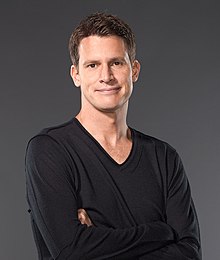User-Generated Content in Education/YouTube
YouTube and Teacher Tube in Education[edit | edit source]
History[edit | edit source]

In 2005, three employees of PayPal, Chad Hurley, Jawed Karim, and Steve Chen, founded the website [YouTube] so that people could upload and share videos. In November 2005, Sequoia Capital gave 3.5 million dollars in funding to YouTube and from there it was officially launched. In April 2006, Sequoia and Artis Capital contributed an additional 8 million dollars to the rapidly growing company. [1]. Within one year of the funding, YouTube was purchased by Google Inc. for 1.65 billion dollars. [2]. At the completion of the sale, Sequoia Capital’s Google shares were estimated at more than $442 million, Chad Hurley’s were estimated at $345 million, Steve Chen’s at more than $326 million, Artis Capital's shares were at more than $83 million, and Jawed Karim’s at more than $64 million. [3]
A lawsuit was brought up against YouTube and Google in March 2007 by Viacom, who claimed that “we must turn to the courts to prevent Google and YouTube from continuing to steal value from artists and to obtain compensation for the significant damage they have caused.” After this event, more than 100,000 videos had to be removed. However, YouTube continued to grow and released versions in many different languages, including Spanish, French, and Japanese. [4].
On March 6, 2007, TeacherTube was officially launched with the purpose of sharing instructional videos to the online community. Jason Smith was a 14-year veteran teacher, coach, and administrator who came up with the idea for this site. It provides the opportunity for teachers to teach students, as well as other teachers, concepts or skills. [5].
Most importantly, TeacherTube community members are a major part of the evolution of the site. Members are encouraged to not only upload educationally relevant videos, but also to make constructive comments and use the rating system to show appreciation for videos of value to one as an educator or learner. [6]
Historical facts[edit | edit source]
The domain name YouTube.com is registered on February 15, 2005.[7].
The first YouTube video is posted on April 23, 2005.[8].
By March 6, 2006, YouTube has 25 million clips, with 20,000 clips being uploaded each day.[9].
YouTube is named Time Magazines' Invention of the Year in 2006.[10].
PC World Magazine named YouTube the 9th of the Top 10 Best Products of 2006.[11].
As of 2010, YouTube reaches over 1 Billion views per day.[12].
TeacherTube was launched on March 6, 2007. [13]
By 2008, TeacherTube has over 26,000 educational videos. [14]
Features[edit | edit source]
YouTube is available in 24 different countries. It is available in more than 30 different languages. [15]. Both sites are free to use and watch videos. Users are able to flag any videos that they feel are inappropriate, which are then reviewed by the staff, and removed if necessary.
TeacherTube offers many great resources for teachers. It also encourages members to upload videos of educational content and worth, to leave comments, and use the rating system for uploaded videos. Teachers can create a digital portfolio to share lesson plans with colleagues all over the world, thus creating a sense of community in education. [16].
YouTube Guidelines[edit | edit source]
Respect the YouTube Community.
Be Responsible.
Don't Cross the Line--Be very aware of what you post.
Free Speech is encouraged, but do not permit attacks.
Do not post misleading information.
Follow Copyright Laws.
Privacy[edit | edit source]
Copyright means that when a person creates an original work of authorship, it is protected by law. Original work can be anything that can be read, heard, and/or seen. A person’s work is protected as soon as it is “created and fixed in a tangible form.” Original work can be either published or not published and still be protected by law.[1]
Creative Commons (CC) is a website that promotes collaboration among the general public and creators. This site allows the general public access to work created by others. People are given the right to use or modify the works of originial authors. There are six CC licenses. These licenses will let authors decide what others can do with their original work.[18].
YouTube takes copyright very seriously. They have established a new technology for copyright holders. It is called Content ID. This is a set of tools that helps people who upload videos to YouTube be able to find their content and allows them to decide what they want to do when they find it. These users may block it, leave it up, or make money from it. If a user believes that a video posted on YouTube is violating their copyright, they may flag the video and select "infringes my copyright" from the list of options provided. This information will then be reviewed by the YouTube board. [19].
Benefits[edit | edit source]
There are many benefits of using YouTube and TeacherTube. Here is a list of some of those benefits:
1. It is Free to use
2. It is user friendly
3. View any video tutorial on any subject
4. Share videos globally
5. Express one’s creativity
6. One can become famous
7. Hidden talents are found
8. Videos are a powerful teaching tool
9. Stay current on any subject
10. Don’t need expensive equipment
Educational Impact[edit | edit source]
Both YouTube and TeacherTube provide educational lectures and instructional videos that teaches new information to the learner or reinforces material that has already been learned. Both sites contain numerous student projects, experiments, and professional development clips even for the teachers. Several colleges, such as the University of California Berkeley and Vanderbilt, have partnered with YouTube to provide the schools with channels for lectures and interactive web-sites. The video-clips allow students to explore the topic beyond the assignment. [20]
Being able to share so much information with others who are so far away can change the role of teachers and students in the future. With this valuable tool, students are able to explore, problem-solve, foster debates, and think critically.
Teacher Tube contains a teaching resources page. Individuals can upload video, documents, audio, and photos. The Teacher Vision section contains lesson pland, printables and more. These resources are organized by subject, grade, and theme. [21]
Criticisms[edit | edit source]
Some YouTube users are breaking the copyright law, because users are uploading videos that they did not make and claiming as their own. Others are posting videos that may be offensive and not socially correct. There are also mature videos and videos with violence in them that are not suitable for young children. Kids also have free rein to watch any video of their choice.[3]
Users have the ability to preserve the integrity of the site by flagging inappropriate videos and copyright violations. TeacherTube staff review flagged sites and will remove any inappropriate posts. With more collegial commentary and discussion through messaging and responses, the quality of this resource will only increase. [4]
Tosh.O[edit | edit source]

YouTube has been a hot topic in the news since its creation. However, on June 4, 2009 YouTube made its debut on Comedy Central in a show called Tosh.O. In its first season it recorded a startling one million viewers per episode. It was noted that by 2010, this show has had up to 2.7 million viewers per episode. This hit-TV show focused on the viral videos that are watched on YouTube. The host, Daniel Tosh, then uses comical language and discusses the videos on the spot to his viewers. There is also a section of each episode known as "Web Redemption" where they invite a person (from a viral video) onto the TV show to defend or explain their actions that were captured on the YouTube video. Daniel Tosh realized the popularity and opportunities that YouTube possessed, created this TV show, and is now extremely successful and profitable.[22]
External Links[edit | edit source]
- http://www.SchoolTube.com is a site that allows parents to enter the classroom when they are unable to attend in person. The student-created content on this site is approved by registered teachers and is safe to share across the US.
- http://www.HotChalk.com is another K-12 site for teachers to collaborate with other teachers and students. It allows students to e-mail assignments to teachers and lets parents log in to check on their child’s grades and progress.
- http://creativecommons.org/about/licenses/ is informaiton on the six CC licenses
References[edit | edit source]
- ↑ http://en.wikipedia.org/wiki/History_of_YouTube accessed March 1, 2011
- ↑ http://www.crunchbase.com/company/youtube accessed March 3, 2010
- ↑ http://logicbank.com/2007/02/09/google-sec-filing-reveals-youtube-investors-win-big/ accessed March 1, 2011
- ↑ http://www.crunchbase.com/company/youtube accessed March 3, 2010
- ↑ http://teachertube.com/staticPage.php?pg=about accessed March 3, 2010
- ↑ http://www1.teachertube.com/staticPage.php?pg=about accessed March 6, 2011
- ↑ http://www.crunchbase.com/company/youtube accessed March 3, 2010
- ↑ http://mediatedcultures.net/ksudigg/?p=108 accessed March 3, 2010
- ↑ http://www.crunchbase.com/company/youtube accessed March 3, 2010
- ↑ http://www.crunchbase.com/company/youtube accessed March 3, 2010
- ↑ http://www.pcworld.com/article/125706-2/the_100_best_products_of_2006.html accessed March 1, 2011
- ↑ http://www.crunchbase.com/company/youtube accessed March 3, 2010
- ↑ http://teachertube.com/staticPage.php?pg=about accessed March 3, 2010
- ↑ http://teachertube.com/staticPage.php?pg=about accessed March 3, 2010
- ↑ http://www.youtube.com/t/faqt accessed March 1, 2011
- ↑ http://teachertube.com/staticPage.php?pg=about accessed March 3, 2010
- ↑ http://www.youtube.com/t/community_guidelines.html accessed March 1, 2011
- ↑ http://creativecommons.org/accessed March 1, 2011
- ↑ http://www.youtube.com/t/faq accessed March 1, 2011
- ↑ http://www.convergemag.com/edtech/Is-Education-Ready-For-YouTube.html accessed March 3, 2010
- ↑ http://www1.teachertube.com/teachervision.php accessed March 6, 2011
- ↑ http://en.wikipedia.org/wiki/Tosh.0
http://teachertube.com/staticPage.php?pg=about accessed March 3, 2010
http://www.crunchbase.com/company/youtube accessed March 3, 2010
http://www.convergemag.com/edtech/Is-Education-Ready-For-YouTube.html accessed March 3, 2010
http://mediatedcultures.net/ksudigg/?p=108 accessed March 3, 2010
http://www.copyright.gov/ accessed March 3, 2010
http://creativecommons.org/ accessed March 3, 2010
http://en.wikipedia.org/wiki/Criticism_of_YouTube accessed March 3, 2010
http://en.wikipedia.org/wiki/Tosh.0 accessed March 2, 2011
Further Readings[edit | edit source]
http://www.copyright.gov/fls/fl102.html - Fair use for education
http://www.archive.org/details/KarlFogel_chalktalk Karl Fogel presents the history of Copyright (2006)
http://www.youtube.com/t/privacy - youtube privacy clause
http://www.teachertube.com/staticPage.php?pg=privacy - teachertube privacy clause
http://www.oercommons.org/ - open educational resources
http://www.time.com/time/magazine/article/0,9171,1569514,00.html - Time Magazine Article
http://www.educause.edu/ELI/7ThingsYouShouldKnowAboutYouTu/156821 - Educase article
http://portal.acm.org/citation.cfm?id=1940761.1940851 - Learning From YouTube article
http://books.google.com/books?hl=en&lr=&id=spo9X16qn30C&oi=fnd&pg=PA173&dq=Youtube+in+education+&ots=rsSJw-nSHz&sig=vsqsZzI2znY3dDn7z5MQN7PbUKc#v=onepage&q=Youtube%20in%20education&f=false - Engaging the YouTube Google-eyed Generation article
